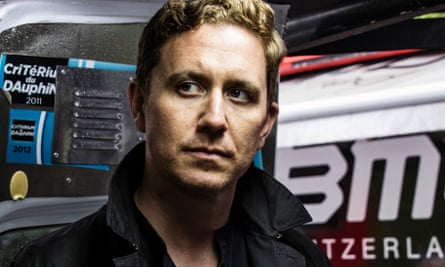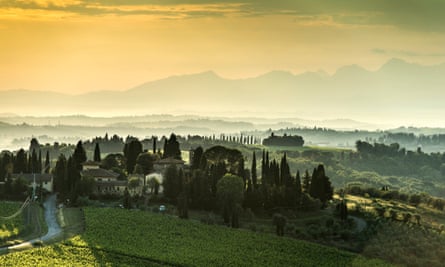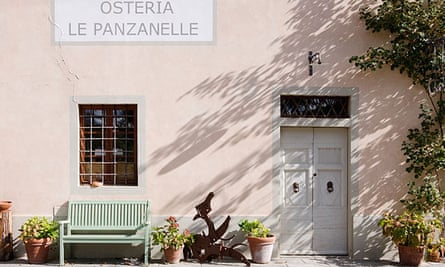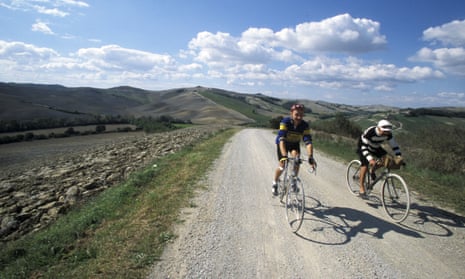There’s nothing I look forward to more each year than the Giro d’Italia – with the possible exception of Christmas dinner at home in Dublin. It heralds the arrival of summer. The weather in May is still capricious, but once you see the pink of the maglia rosa you know long, sun-drenched days are not far off.
This year is the 100th edition of the cycle race, so it’s going to be pretty special. It ingrains itself into everyday life in a way few cultural events can. One of this year’s stages departs from the village of Ponte a Ema near Florence, birthplace of the great Gino Bartali, three-time winner of the Giro.

A few years ago, a group of us recreated one of the training rides Bartali was famous for. My friend, former pro João Correia, who runs a cycling holiday company in Chianti called inGamba, organised a 200km ride across Tuscany to Assisi, in Umbria. Afterwards, we drove back over the border to Terontola, whose railway station has a plaque to Bartali’s war efforts. He ferried documents around Italy, hidden inside his bicycle, to help Jewish families escape the fascist regime. It’s also still home to Ivo Faltoni, who was Bartali’s mechanic when he was just 16. It’s hard to imagine a day on the bike quite like that anywhere else in the world.
Not all days are like that, but I always enjoy riding in Chianti. A good place to start is Siena, which is the perfect medieval city, centered on the magnificent Piazza del Campo. But on a bike, in 10 minutes, you can be out on a little dirt road through a vineyard. And that feeds into the personality of the place. It’s quite urban in the sense that it’s stylish, with lots of little boutiques selling handmade shoes and the like, but when you go into the trattorias or the enotecas or markets, there’s a tangible connection to the land outside the city gates – in the local prosciutto, wine and vegetables.

I always come back a kilo or two heavier. There’s an embarrassment of riches when it comes to food. After a little time there, you come to realise that the rest of us are missing out on something. An example of that is my favourite restaurant in the world. Osteria Le Panzanelle is on the road between Panzano and Radda. Blink and you’d miss it. It’s a classic Italian country trattoria – simple, with whitewashed walls – which belies its brilliance. The menu is short and seasonal, and the wine list is fabulous. It does amazing rabbit, and the best pannacotta ever, even if I never order it, because its homemade cantucci biscuits with vin santo are too good to ignore.
Castello di Ama was one of the first Chianti producers to treat it as a serious wine. It’s a family-run vineyard in a 12th-century hamlet near Gaiole, and has a nice restaurant and a quite serious art collection, with works by Anish Kapoor, Michelangelo Pistoletto and Hiroshi Sugimoto.

The Disneyfied idea of Chiantishire is at odds with the real Chianti. My favourite time to go is in spring, or autumn for the vintage cycling event L’Eroica in Gaiole. The ride takes place on the strade bianche, the stony tracks Bartali would have ridden every day. You get the full colour of Chianti then, when its character has not been bleached out by the sun or lost in the tourist crowds. It’s always beautiful, but there’s a real working class culture. Most people are labourers or work on the land. It’s a million miles away from millionaire villas and convertibles.
I love it when you go for a coffee in the morning, in one of Chianti’s little villages, and there might be someone in the bar who’s left his battered van parked up with a freshly shot wild boar in the back. Then 20 minutes later, I could be in elegant Siena, getting another shot of espresso at Torrefazione Fiorella, an old roasters not far from Piazza del Campo.

It’s a hard place, and that’s why it produced cycling legends such as Bartali and Fiorenzo Magni, another three-time Giro winner. A lot of cyclists are shocked to find that there aren’t the long climbs of the Dolomites or the Alps. But the roads twist and roll, the weather can turn quickly, and when you’re on the gravel strade bianche, you’re at the mercy of good fortune. And that’s the real Chianti.









Comments (…)
Sign in or create your Guardian account to join the discussion